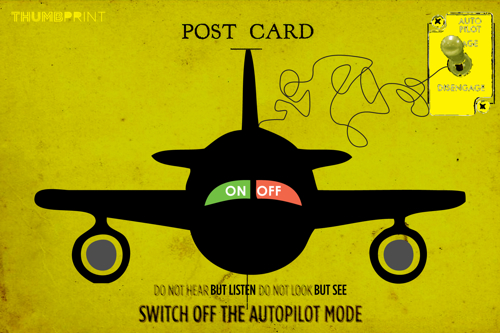Article in brief: How does a person turn the “Autopilot” mode off? Are there things that can help minimize the time spent in “Autopilot”? Is it possible to consciously get out of it?

The previous article “Autopilot OFF” discussed the state of “Autopilot”, the reason why people go into this state and the negative impact it has on a person’s life. After being made aware and understanding the impact of the “Autopilot” mode, the next thing to do is to find ways to minimize its time.
When in “Autopilot”, people usually don’t realize they are in it and sometimes only snap out of it when something alerts them or their trail of thoughts is cut. However, over the years, a few methods have been developed that proved it is possible to control the time someone spends in “Autopilot” and can consciously snap out of it when desired.
The methods are not difficult or time consuming at all; they only require practice. One of the simplest methods to follow is to take time to concentrate on nothing but the person’s surroundings. Even if seconds at a time, this will help train a person’s brain to automatically check their surroundings thus pulling them out of “Autopilot” quicker than usual.
Being aware of one’s surroundings doesn’t happen only by being aware of where this person is, but also in the questions to ask while trying to comprehend one’s surroundings, such as:
- Where am I sitting? Is this seat comfortable? Is it hurting my back? Am I sitting straight? Is my posture correct?
- Am I inside or outside? What’s the weather like? Is it hot or cold? Is it dark or bright?
- What are the sounds around me? Is the A/C on? Are the people around me loud or is it quiet?
There isn’t a list per se that a person has to go through to be aware of their surroundings; it is simply a matter of being aware of everything that is around.
Another method is to consciously go somewhere to enhance their senses. Whether that is taking a shower or going outside to feel the sun or the wind, the idea is to go somewhere to increase the sensation of our senses. For example, take 5 minutes to stand outside and feel the sun, the wind, the sounds, the colors, the noise and everything else that can be sensed.
The more a person trains themselves to be aware of their surroundings and practices on enhancing their senses, the less they will be stuck in “Autopilot” and the more they will be in control of their lives. Practicing those methods can also help in other matters such as fixing one’s posture, help eating healthier and refresh one’s relationships.
The decision to practice these methods and change your life ultimately comes down to this question: “Do I want to live on Autopilot or do I want to live?”
——————–
Dictionary:
- Autopilot: functioning in an unthinking or reflexive manner.
References:
- “Don’t live in default mode.” Living the Balanced Life RSS. N.p., 7 Mar. 2011. Web. 13 Feb. 2014. <http://livingthebalancedlife.com/2011/dont-live-in-default-mode/>.
- Fayle , Alex . “Motivate Thyself.” Motivate Thyself. N.p., 11 June 2009. Web. 13 Feb. 2014. <http://motivatethyself.com/9-steps-to-turn-off-the-autopilot-and-start-living-your-dreams/>.
- “Free PLR Article Directory.” Free PLR Article Directory. N.p., n.d. Web. 13 Feb. 2014. <http://plrplr.com/73403/how-to-stop-living-your-life-on-autopilot/>.
- McGuire, Adrienne . “How to Turn off Auto-Pilot and Live Your Life to the Fullest.” Tiny Shift. N.p., 24 Sept. 2012. Web. 13 Feb. 2014. <http://www.tinyshift.com/how-to-turn-off-auto-pilot-and-live-your-life-to-the-fullest/>.



